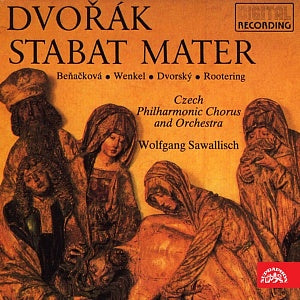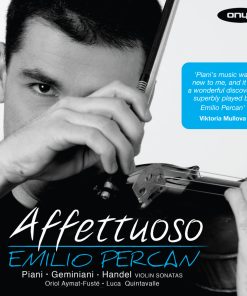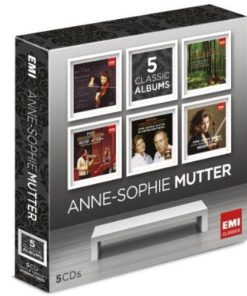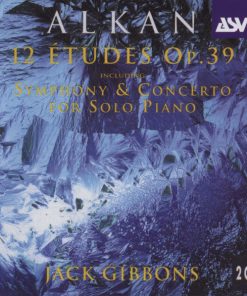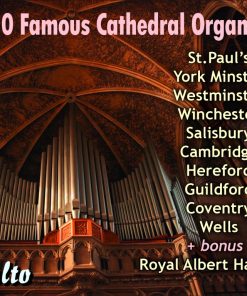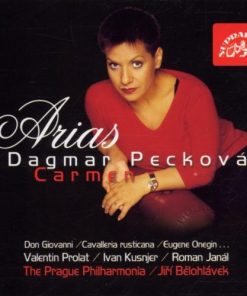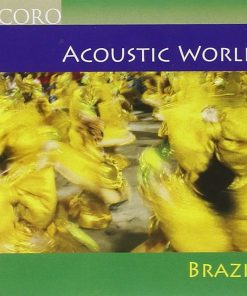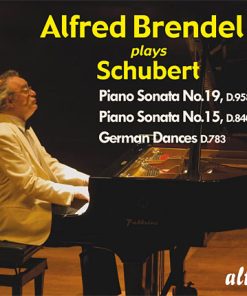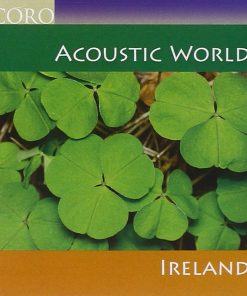DVORAK: Stabat Mater – Czech Philharmonic Orchestra, Wolfgang Sawallisch (2 CDs) SUPRAPHON
$ 3,99 $ 2,39

The fascinating poetic text of the medieval sequence Stabat Mater attributed mostly to an Italian lawyer and later a monk of the Order of the Franciscans, Jacob de Benedictis, known as Jacopone da Todi (cca 1230-1306) after the place of his birth, inspired countless composers to write music that in some cases ranks with their greatest works. Among the most outstanding names we might mention Josquin Desprez, G. P. Palestrina, G. Tartini, A. Scarlatti, G. B. Pergolesi, J. Haydn, G. Rossini, G. Verdi, K. Szymanowski and K. Penderecki, and among our composers J. B. Foerster and F. Musil.
We can only hazard a guess as to what inspired Antonín Dvořák to set this Latin terza rima liturgical text to music, and why he chose a concept quite different from the music of others: it probably was that tendency “from darkness to light” which later infused Strauss’s “Tod und Verklärung”; however, we already know of this in the best symphonic works of classicism, notably in L. v. Beethoven. The initial stage of pain and suffering gradually undergoes a catharsis up to the final, clear, hopeful view. Thus after a picture of the doleful Calvary we then find tones that are pleasing, soothing, with firm Dvořák rhythms almost like a dance or a march.
1875 was one of the most fruitful years in Dvořák’s life: it marked the completion of his opera The Stubborn Lovers, the string quintet in G major, the first of the four Moravioan Duets, the piano trio in B flat major, the enchanting string serenade in E major, the piano quartet in D major, the Symphony in F major and the big five-act opera Wanda. We do not know why Dvořák’s writing at the very outset of 1876 shows certain melancholy features, beginning with the piano trio in G minor, the quartet in E major (but mostly in minor in fact) and reaches what can only be called tragic tones in the sketch of Stabat Mater (February-May 1876). It can hardly be attributed only to the death of his two-day old daughter Josefa in September 1875; after all, his son Otakar was getting along well and there already was the hope of another family addition. The fact is that Dvořák put aside the completed sketch of Stabat mater and in the summer 1876 wrote two more cycles of Moravian Duets, the cycle Evening Songs, to words by V. Hálek, and the piano concerto in G minor. Almost exactly a year after the birth of his first daughter, a second daughter, Růženka, was born. Dvořák was now busily writing again: besides some minor compositions, he wrote his opera The Cunning Peasant and the Sympohinic variations op 78, originally 28, the same number which Stabat Mater was originally given.
And now new blows struck the composer: on August 13, 1877, růženka passed away, and on September 8, on the composer’s birthday, his son Otakar of three years and six months died. Suddenly the Dvořáks were without any children.
The composer seized upon the sketch he had laid aside and with redoubled emotional intensity he again traversed that path “from darkness to light”. During October and the first half of November 1877 he wrote and completed the orchestral score in whose tragic and ultimate inner, allhuman optimism he dissolved his own, personal pain.
Dvořák had no idea he had written a work which was to ensure him permanent and fundamental success in the Anglo-Saxon world, just as the Moravian Duets and the Slavonic Dances cut a path into the German world. Not quite three years after the Prague premiere (December 23, 1880), it was performed in London (March 10, 1883) and the success was so great that it can only be compared with the triumphs of Händel and Haydn: Dvořák was invited the following year to personally coduct a repeat performance, marking the beginning of his English tours and commissions for new compositions. Simrock in Berlin published the composition in 1881 but for commercial in the critical edition of Dvořák’s works in 1958.
Dvořák divided the whole text into ten musical numbers; each of them has a firm musical form and a well-defined individual content. The longest is the introductory part setting four terza rima to music; F sharp tones quietly form an arch followed by achromatic descent painting in livid colours the scene of the Crucifixion, the chorus only whispering, fragmentarily daring to utter a sound on the whole stark horror of the moment. The solo quartet of the second number, also set to four terza rima, is a reflective discussion mirroring the human view of what was depicted in number one. The third number, in which only one terzarima is set to music (just as numbers 5, 7 and 10) is a ceremonial funeral march. In number 4 the emotional appeal of the bass solo contrasts with the engelically crystal entry of the women’s chorus “Sancta Mater…” . choral number five, in flowing movement and mostly clear harmonies, is like the promise of manfully bearing all suffering while viewing the calvary scene. The sixth number, in which the solo tenor alternates with the male chorus, is a simple folk approach of a village lad longing to participate in showing his devotion to Mother and Son. Choral number seven, “Virgo virginum…”, is like an infinitely, perspective Baroque drawing in a village church. In the next, the eighth, number, a soprano and tenor duet, small but loftylegatos blend and mesh in an andless sequence. The next, the ninth, alto solo “Inflammatus…” begins in a Händel-like manner and after it there appears – in a different instrumentation – a flashback to the first picture of the work, the scene of the calvary, and a reminder that all of us are mortal: but death is not as bad as dying: the final, tenth, Amen, recalling the old maters of Czech baroque and foreshadowing the later, severe Amen of Janáček, floods everything with its joyful brightness of hope.
The Händel-like greatness, breadth and thickly suffused colour makes Dvořák’s Stabat a work in which the traditions of Czech musical Baroque were revived, a Baroque more simple than was the German or Italian, but no less passionate in expression, depth of feeling and monumental in its pathos.
Wolfgang Sawallisch (born in 1923 in Munich) first studied piano with Wolf Ruoff and only later conductiong at the Munich College of Music where his professor was Josef Haas. He began his conducting career in 1947 in Augsburg, from 1953 was in Aachen, eventually returning to his native Munich via Wiesbaden and Cologne. Today he is the general music director and simultaneously the manager of the State Opera. We first heard Sawallisch in Prague conducting the Czech Philharmonic Orchestra during the Prague Spring festival of 1958 and since then he has been a guest at this festival seven times more. In between, however, he has also been a guest conductor of the Czech Philharmonic and we even heard himas a pianist with Josef Suk as his sonata partner. Sawallisch, as one of the leading opera conductors today and a great admirer of Czech music, literally fell in love with the Czech Philharmonic Chorus which he conducted in big oratorios and cantatas (he even invited it in 1964 to the Milan La Scala for several performances of Wagner’s Lohengrin). He very gladly visits us tocollaborate both with the Czech Philharmonic Orchestra and its chorus. His visits to the Prague Spring festival in recent years, when he conducted the Beethoven Ninth, are eloquent testimony of this. Stabat Mater is therefore the consistent and logical continuation of a number of Sawallisch’s great artistic creations in this sphere.

CD 1
Antonín Dvořák
Stabat Mater. Oratorio for Soloists, Chorus and Orchestra, Op. 58
1. Stabat Mater dolorosa (Andante con moto) /Soprano, contralto, tenor, bass, Chorus/ 20:58
2. Quis est homo, qui non fleret (Andante sostenuto) /Soprano, contralto, tenor, bass/ 10:41
3. Eja, Mater, fons amoris (Andante con moto) /Chorus/ 07:30
4. Fac, ut ardeat cor meum (Largo) /bass, Chorus/ 08:36
CD 2
Antonín Dvořák
Stabat Mater. Oratorio for Soloists, Chorus and Orchestra, Op. 58
1. Tui Nati vulnerati (Andante con moto, quasi allegretto) /Chorus/ 06:27
2. Fac me vere tecum flere (Andante con moto) /tenor, Chorus/ 08:05
3. Virgo virginum praeclara (Largo) /Chorus/ 07:22
4. Fac, ut portem Christi mortem (Larghetto) /soprano, tenor/ 06:19
5. Inflammatus et accensus (Andante maestoso) /contralto/ 06:37
6. Quando corpus morietur (Andante con moto) /soprano, contralto, tenor, bass, Chorus/ 07:51
Fast Shipping and Professional Packing
Due to our longstanding partnership with UPS FedEx DHL and other leading international carriers, we are able to provide a range of shipping options. Our warehouse staff are highly trained to pack your goods exactly according to the specifications that we supply. Your goods will undergo a thorough examination and will be safely packaged prior to being sent out. Everyday we deliver hundreds of packages to our customers from all over the world. This is an indication of our dedication to being the largest online retailer worldwide. Warehouses and distribution centers can be located in Europe as well as the USA.
Orders with more than 1 item are assigned processing periods for each item.
Before shipment, all ordered products will be thoroughly inspected. Today, most orders will be shipped within 48 hours. The estimated delivery time is between 3-7 days.
Returns
The stock is constantly changing. It's not entirely managed by us since we are involved with multiple parties such as the factory and our storage. The actual stock can fluctuate at any time. Please understand it may happen that your order will be out of stock when the order is placed.
Our policy is valid for 30 days. If you haven't received your product within 30 days, we're not able to issue either a return or exchange.
You are able to return a product if it is unused and in the same condition when you received it. It must also still remain in the original packaging.
Related products
MUSIC CD
MUSIC CD
MUSIC CD
MUSIC CD
MUSIC CD
